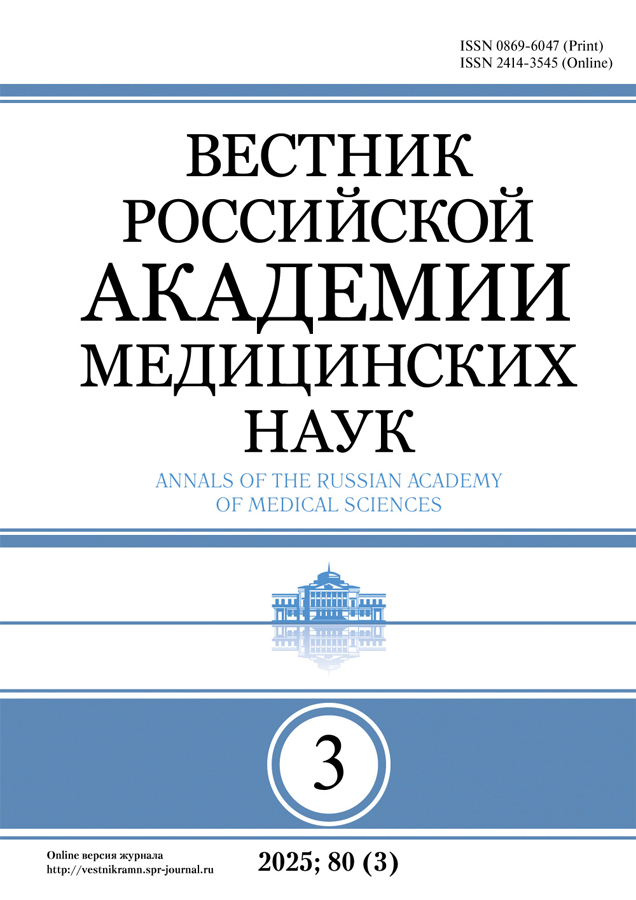Диагностические и прогностические возможности электрохимических измерений редокс потенциала плазмы крови
- Авторы: Сергиенко В.И.1, Хубутия М.Ш.2, Евсеев А.К.3, Пинчук А.В.2, Новрузбеков М.С.2, Луцык К.Н.2, Гольдин М.М.2
-
Учреждения:
- ФГБНУ «Научно-исследовательский институт физико-химической медицины ФМБА»
- ГБУЗ города Москвы «НИИ скорой помощи им. Н.В. Склифосовского ДЗМ»
- ФГБОУ ВПО «Российский химико-технологический университет имени Д.И. Менделеева»
- Выпуск: Том 70, № 6 (2015)
- Страницы: 627-632
- Раздел: АКТУАЛЬНЫЕ ВОПРОСЫ БИОХИМИИ
- Дата публикации: 09.12.2015
- URL: https://vestnikramn.spr-journal.ru/jour/article/view/572
- DOI: https://doi.org/10.15690/vramn572
- ID: 572
Цитировать
Полный текст
Аннотация
Цель исследования: определение операционных характеристик теста на основе мониторинга величин редокс-потенциала плазмы крови пациентов с различными патологическими состояниями, сопровождающимися нарушениями кислородного обмена в процессе лечения; расширение спектра параметров разработанного нами метода исследования редокс-потенциала плазмы крови.
Методы: обследованы группы практически здоровых добровольцев (n =63) и пациентов со следующими патологиями: с трансплантацией почки (n =59), печени (n =64) и легкого (n =7). Измерения редокс-потенциала проводили на платиновом микроэлектроде относительно насыщенного хлорсеребряного электрода сравнения. Потенциостат IPC-Pro L (НПФ «Вольта») был использован для записи зависимостей потенциала от времени. Время регистрации составляло 15 мин.
Результаты: обнаружены статистически достоверные различия в диапазонах величин редокс-потенциала для практически здоровых людей и пациентов с трансплантированными почкой и печенью. Доля измеренных величин редокс-потенциалов, совпадающих с величинами, находящимися в пределах доверительного интервала редокс-потенциалов практически здоровых людей, составила 12% для пациентов с трансплантированной почкой и 10% для пациентов с трансплантированной печенью. Обнаружено существенное различие в характере изменений величин редокс-потенциала плазмы крови при мониторинге подгрупп пациентов с наличием и отсутствием осложнений после трансплантации печени. Найдено, что чувствительность электрохимического метода определения величин редокс-потенциала плазмы крови составила 85,7%, специфичность — 69,8%, точность — 85,2%.
Заключение: обнаружены диапазоны величин редокс-потенциала плазмы крови, характерные для различных патологических состояний; установлена связь эффекта проводимого лечения с количественными изменениями величин редокс-потенциала плазмы крови пациента; предложен критерий для раннего прогнозирования осложнений у пациентов с трансплантированной печенью на основе мониторинга редокс-потенциала в послеоперационном периоде.
Ключевые слова
Об авторах
Валерий Иванович Сергиенко
ФГБНУ «Научно-исследовательский институт физико-химической медицины ФМБА»
Автор, ответственный за переписку.
Email: niifhm@fmbamail.ru
академик РАН, д.м.н., проф., директор ФГБУН НИИ ФХМ ФМБА России Россия
Могели Шалвович Хубутия
ГБУЗ города Москвы «НИИ скорой помощи им. Н.В. Склифосовского ДЗМ»
Email: sklifos@inbox.ru
член-корр. РАН, д.м.н., проф., директор ГБУЗ «НИИ СП им. Н.В. Склифосовского ДЗМ» Россия
Анатолий Константинович Евсеев
ФГБОУ ВПО «Российский химико-технологический университет имени Д.И. Менделеева»
Email: anatolevseev@gmail.com
к.х.н., ведущий инженер РХТУ им. Д.И. Менделеева Россия
Алексей Валерьевич Пинчук
ГБУЗ города Москвы «НИИ скорой помощи им. Н.В. Склифосовского ДЗМ»
Email: avpin@rambler.ru
к.м.н., заведующий отделением трансплантации почки и поджелудочной железы Россия
Мурад Сафтарович Новрузбеков
ГБУЗ города Москвы «НИИ скорой помощи им. Н.В. Склифосовского ДЗМ»
Email: NMS@bk.ru
к.м.н., заведующий отделением трансплантации печени Россия
Константин Николаевич Луцык
ГБУЗ города Москвы «НИИ скорой помощи им. Н.В. Склифосовского ДЗМ»
Email: s.urg@mail.ru
к.м.н., заведующий отделением острых хирургических заболеваний печени и поджелудочной железы Россия
Марк Михайлович Гольдин
ГБУЗ города Москвы «НИИ скорой помощи им. Н.В. Склифосовского ДЗМ»
Email: markmgold@gmail.com
д.х.н., проф., ведущий научный сотрудник лаборатории клеточных и физико-химических медицинских технологий Россия
Список литературы
- Rael LR, Bar-Or R, Aumann RM, Slone DS, Mains CW, Bar-Or D. Oxidation-reduction potential and paraoxonase arylesterase activity in trauma patients. Biochem Biophys Res Commun. 2007;361(2):561–565. doi: 10.1016/j.bbrc.2007.07.078
- Хубутия МШ, Евсеев AK, Колесников ВA, Гольдин MM, Давыдов АД, Волков АГ, Степанов АА. Измерения потенциала платинового электрода в крови, плазме и сыворотке крови. Электрохимия. 2010;46(5):569–573.
- White NJ, Collinson MM, Boe RA, Ward KR. Redox monitoring reveals increased susceptibility of whole blood to oxidative stress during hemorrhagic shock. Circulation. 2008;118:1488.
- Michaelis L. Oxidation reduction potentials. London: J. B. Lippincott Company. 1930. 199 p.
- Rael LT, Bar-Or R, Salottolo K, Mains CW, Bar-Or D. Injury severity and serum amyloid A correlate with plasma oxidation-reduction potential in multi trauma patients: a retrospective analysis. Scand J Trauma Resusc Emerg Med. 2009;17:57. doi: 10.1186/1757-7241-17-57
- Frumkin AN. Points of zero charge in equations of electrochemical kinetics. J Electroanal Chem. 1965; 9: 173–83. doi: 10.1016/0022-0728(65)80014-6
- Bartlett PN. Bioelectrochemistry: Fundamentals, Experimental Techniques and Applications. Chichester: John Wiley& Sons. 2008. 494 p. doi: 10.1002/9780470753842
- Khubutiya MSh, Goldin MM, Romasenko MV, Volkov AG, Hall PJ, Evseev AK, Levina OA, Aleschenko EI, Krylov VV. Redox potentials of blood serum in patients with acute cerebral pathology. ECS Transactions. 2010;25(19):63–71. doi: 10.1149/1.3298950
- Grosz HJ, Farmer BB. Reduction oxidation potential of blood as a function of partial pressure of oxygen. Nature. 1967;213(5077):717–718. doi: 10.1038/213717a0
- Гольдин ММ, Ромасенко МВ, Евсеев АК, Левина ОА, Петриков СС. Алещенко ЕИ, Крылов ВВ. Оценка эффективности использования гипербарической оксигенации при острой церебральной патологии с помощью электрохимической методики. Нейрохирургия. 2010;4:33–39.
- Bar-Or D, Bar-Or R. Measurement and uses of oxidative stress. Patent US №2010/0267074 A1 от 21.10.2010. Заявка US 12/625,072 от 24.09.2009.
- Goldin MM, Khubutia MSh, Evseev AK, Goldin MM, Pinchuk AV, Pervakova EI, Tarabrin YA, Hall PJ. Noninvasive Diagnosis of Dysfunctions in Patients After Organ Transplantation by Monitoring the Redox Potential of Blood Serum. Transplantation. 2015;99(6):1288–1292. doi: 10.1097/TP.0000000000000519
- Morris PJ, Knechtle SJ. Kidney transplantation: principles and practice. Philadelphia: Elsevier Saunders. 2014. 880 p.
- Klein AA, Lewis CJ, Madsen JC. Organ transplantation. A Clinical Guide. Cambridge University Press. 2011. 386 p. doi: 10.1017/CBO9780511994876
- Couture KA. The Lung Transplantation Handbook (Second Edition): A Guide for Patients Paperback. Trafford Publishing. 2001. 282 p.
- Флетчер Р, Флетчер С, Вагнер Э. Клиническая эпидемиология. Основы доказательной медицины. М.: Медиа Сфера. 1998. 346 с.
Дополнительные файлы








